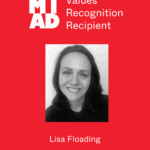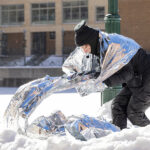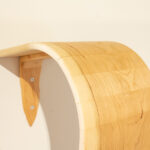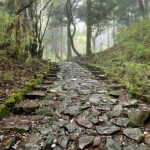Out of the Suitcase II: Mary L. Nohl Fund Suitcase Award Winners
Oct. 19 – Dec. 15
Twenty-two artists and works from venues around the world come together in “Out of the Suitcase II: Mary L. Nohl Fund Suitcase Award Winners” – an exhibition running through December 15, 2007.
“Out of the Suitcase II” shows the works of some of the artists who received grants from the Greater Milwaukee Foundation’s Mary L. Nohl Suitcase Fund to take their art to significant venues worldwide, thereby introducing new audiences to the excellent art produced in the Milwaukee area. The venues include Austria; Beijing, China; Calgary, Canada; Dallas; St. Louis; Minneapolis; New York City and Seattle.
MIAD Director of Galleries Mark Lawson and UW-Milwaukee’s Director of INOVA Bruce Knackert are curators.
Lawson said, “The 22 artists have a diverse range of work, such as MIAD Faculty Sonja Thomsen’s quietly luminous photographs; MIAD Faculty Lynn Tomaszewski’s thoughtful yet simply rendered drawings; and John Riepenhoff’s installation, ‘The John Riepenhoff Experience,’ which creates an exhibit within the exhibition showing the work of MIAD alum Paul Druecke.”
Describing the works as “an informative cross-section of the art scene in the Milwaukee region,” Lawson said, “They represent many of the vibrant tangents of art-making occurring at this time in our community.”
Additional works include installations, video works, assemblages, photographs, paintings, drawings and sculpture. Participating artists are: Beki Borman MIAD ’04, Kyoung Ae Cho, Larry D’Attilio, Paul Druecke MIAD ’87, Greg DuMonthier MIAD ’90, Nicholas Frank, Jean Roberts Guequierre; Sonji Hunt; Laura Ibbotson, MIAD Faculty Darryl Jensen; Yevgeniya Kaganovich; Shelby Keefe; MIAD Faculty Colin Matthes; Jim Muraco; Michaela O’Herlihy; MIAD staff Josie Osborne; Kristopher Pollard; John Riepenhoff; Richard Taylor MIAD ’74; MIAD Faculty Sonja Thomsen; MIAD Faculty Lynn Tomaszewski and The WhiteBoxPainters (Brent Budsberg, Mark Escribano and MIAD Faculty Shana McCaw).
Running concurrently in the Layton Gallery through Nov. 17 is “Media Projects 2007,” showing the video works of internationally renowned, New York-based artist Catherine Ross. Ross’ works examine popular American culture in the 60’s through an innovative sampling of period television clips. Among her honors, Ross received the “Best International Short Award” at Dublin’s 2006 Darklight Festival.
{mospagebreak title=Artist Bios and Statements}
Kyoung Ae Cho
For millions of years, nature has been conducting continuous experiments into processes. The environment has been metamorphosing natural materials as civilization and technologies change. My investigation into environmental processing explores nature’s rhythm in our culture and how we interact with nature. Every day we hear of environmental tragedies that result in the loss of living elements. As concern grows about the environment, our ability to understand nature’s rhythm and our willingness to recycle materials have become more important. This situation has piqued my interest and inspired my work.
My works are produced as a result of an ongoing conversation between myself and nature. Gathering and collecting objects and materials is essential to my working process. I respectfully approach environmental processing by incorporating recycled matter as well as low-valued man-made materials, most of which I have gathered, in my work. From the moment of collecting, a collaboration between these objects and materials and myself begins. In the process I examine nature and its changes to understand the elements of its language: shape, pattern, color, texture, scale. I need to understand this language to create work that carries the beauty and power that I see and feel in nature.
My creative research has been based on beauty in nature, exploring the idea of pattern making, incorporating/borrowing patterns in nature, and harmonizing natural and man-made (man-processed) materials. Utilizing wood grain, I create forms and patterns reflecting the rhythm and order found in nature. Small pieces of wood or leaves are put together with fabric and thread, revealing and celebrating not only their beauty but also the simultaneous fragility and endurance of nature. While working on pieces I also think of the harmony between the natural and the man-made, the spiritual and the physical.
The results of this investigation take many forms: fiber objects, sculpture/woodworking, and installations that involve processes of woodcarving, sewing, stitching, piecing, fusing, laminating, and so on. The merger of fibers and sculpture comes naturally in my work; Pattern incorporated pieces with wood grain and knots, hand-stitched fabric pieces with leaves, carved wood pieces and installation piece.
Paul Druecke
Lori Waxman, art critic and historian, writes on wikipedia.com, “Paul Druecke is an American artist based in Milwaukee, Wisconsin. Since 1995 Druecke has been creating and exhibiting projects that deal with public space, social interaction, and personal identity. His projects take the form of public events, exhibitions, multi-media works, and books; the projects invite participation and blur traditional notions of authorship. His work is best understood within the context of conceptual art.”
Sonji Hunt
Artist Statement
I am a Formalist. Movement, color and texture are of the utmost importance to me. My giant, iconic leaves and pods travel through environments and situations conveying visual dialogues. My bundles add structure and contain the energy of all living things in their wrapped contents. I have always viewed everyday physical surroundings and experiences through fragmented lenses. Then, I deconstruct and reassemble it all into something else. The shapes tell a story.
Bio
Sonji Hunt is a painter and fabric artist. She received both her BFA and MFA in Drawing and Painting from the University of Wisconsin-Milwaukee, in Milwaukee, Wisconsin. Most recently, she has exhibited her work in Minnesota, Oregon, Ohio, Tennessee, Massachusetts, Arkansas and Wisconsin. Sonji has two pieces that are part of a national touring exhibition called “Textural Rhythms: Constructing the Jazz Tradition” curated by Dr. Carolyn Mazloomi.
Laura Ibbotson
Bio
Laura Ibbotson received a B.A. in art from Wisconsin Lutheran College. In June of 2003, she was the artist-in-residence at Whitefish Dunes State Park in Door County, WI. Since then, her paintings have been exhibited in shows organized by the Maryland Federation of Art; the Missouri Watercolor Society; the Anderson Arts Center, in Kenosha, Wisconsin; and the Forbes Gallery in New York. She maintains a studio in Milwaukee. For more information on Ibbotson visit www.LauraIbbotson.com.
Artist Statement
My work is drawn primarily form the complex multilayered patterns in nature, especially the twisted and tangled branches in trees. The tangled branches are a reflection of intricate relationships and emotions in life. Using the land as a metaphor for those relationships, parts of nature become significant that are sometimes overlooked.”
Darryl Jensen
Figures follow me in all of the art I make. A short time after graduate school, I began working with figurative images appropriated from black and white Film Noir and B-grade horror movies. As an ardent admirer and student of American Cinema and Film History, my obsession with film has merged with my investigations as a narrative artist.
By appropriating film stills, I trigger automatic associations of the movie theatre viewing experience. As within a movie, certain moments in the timeline of an individual’s life are highlighted and can be recalled with horrifying clarity. Each film still reflects my own sense of how one’s emotional scars are like visions out of time. The information within one film still implies both the time before as well as the time immediately after. This implied timeline naturally reflects life’s tendency for emotional evolution beyond these highlighted, momentary visions of trauma.
I specifically use these appropriated and thematically vague references, hinting at the darker taboo realms of sex and violence, to encourage the viewers’ own nature to identify themselves as my protagonists.
Yevgeniya Kaganovich
In my work I address the complexities of inner-personal and social interactions conditioned by the corporal body. I explore the absurdity of our attempts to express, perceive, communicate and understand. I think of the pieces I create as body extensions that display a psychological condition, and as projections of mental habits and bodily knowledge. Combining the conventions of fine and applied art allows me to create objects that communicate ideas through their implied use. I rely on the suggested function within the piece to create ambiguous tension between enhancing and prohibiting, amplifying and restricting, enabling and inhibiting.
By presenting the object as a residual trace of the body on an actual scale I want the viewer to mentally enter the work with their own body and relate to the futility of the human effort. The objects look like what it feels like to desperately want to communicate and not be able to. To attempt to understand and fail. To scrutinize something so closely the effort becomes absurd. To feel urgently vulnerable to the point of becoming aggressive. I envision these pieces as solidified gestures, physical reminders of a hypered experience, as remnants of our ways of operating in the world.
These objects have a sense of being both for and of the body and have both artifact and specimen qualities. I try to create objects that are ambiguous in their nature, their function hindered, their use frustrated and their origin unclear. I attempt to make fictions that precipitate out of our own reality and experiences, rendering them as uncertain and unreliable. By pointing out the conflicts and dualities in our existence through bodily objects I intend to encourage both introspection and outreach.
Shelby Keefe
Contemporary Impressionist Painter
I am an established oil painter having experience in this medium for over 30 years. I am committed to furthering my growth as an artist and also to share my talents and techniques with the community at large. I attribute my commercial success to my technique and subject matter, painting mostly architectural landscape, (urban and rural), figurative and some still life. Being what I consider to be an impressionist, my work is representational but freely rendered, letting the paint ìdo the talkingî. I try not to force my oils into super-realism or photo-realism because I get too much enjoyment out of laying a simple brush stroke down that says many things very efficiently. I also think a work of art has a much longer-lasting impression and a longer ìwall lifeî if the viewerís imagination is required to fill in the details rather than spelling everything out for them.
Teacher
I teach that making art, being around art and thinking creatively is essential for human fulfillment and quality of life. I believe that ALL people have creativity within–whether they are a self-proclaimed ìnon-artist,î a degreed professional, or a Sunday dabbler. My contribution as a teacher involves direct and individualized instruction to all levels of experience with some focus on doing painting demonstrations for classes, large artist groups and fund-raising events for non-profit organizations.
Performance Artist
I have recently integrated my expertise as a painter and my mission to demystify the painting process by doing painting performances. These differ from demos in that I am not ìinstructingî, but ìdancing on canvasî with my paints. In these performances, I create a finished oil painting to dynamic music in about 20 minutes and usually have good-sized audiences looking on. The resulting intuitive works are extremely loose, colorful and juicy representations of themes appropriate for the performance event. These paintings are the most authentic expressions of my painting ability and give me the utmost satisfaction because the process of doing them taps into a power greater that myself. The combination of the ìneed for speedî and the pressure of being watched brings out in me an aspect of myself that doesnít happen in the private comfort and calm surroundings of the studio. I want to explore this intuitive process much more deeply and on a larger scale in coming years.
Micaela O’Herlihy
Micaela O’Herlihy is obsessed with the making of things. She makes artworks in a multitude of media just so that she can get to the root of the material and develop an intimate relationship with it. She and her little (yet rapidly expanding) family live in the driftless region of Wisconsin where she makes art out of nearly anything she can get her hands on. Namely things with a mind of their own, things that with a little help from Micaela grow into something on their own accord. Things like mushroom spawn, wood, mini dv cassettes, walnut ink, fireflies, hay, sawdust, burlap, film and mouse nests.
Josie Osborne
Simplicity of form, color and composition in response to everyday sensory experiences of sound, rhythm, light and shadow, memories of touch and textures, has become increasingly important to me in my recent work. In response to life’s increasing complexity and pace. I have felt an urgency to create work that offers the viewer opportunities for contemplation and solace. Many are small-scale homages to those who have come before me like Agnes Martin, Bryce Marden, Kurt Schwitters and Joseph Cornell.
I often still look to the written word, found text and poetry as important stepping-off points. In the assemblage pieces, the elements used and the organization or treatment of space references dreams, architecture, and modernist language of color simplicity, and mark making. They place the necessary openness to non-physical possibility in parallel to that which we physically experience in the world.
Kristopher M. Pollard
My drawings depict characters as part of a narrative or a study. Themes of absurdity, humor, sexuality, solitude or fear continually surface in the work. The process comes from compiling seemingly unrelated figures, gestures and text, and imagining new connections between them. Using this method is an attempt to make the connections truly haphazard in order to make more natural discoveries.
Lynn Tomaszewski
My work begins with gathering information. This information can be in the form of patterns of
motion in space or genetic data or maps of objects or events. Both the video and the
drawings use technology to gain new perspectives. The technology is used either to alter the
amount of information being perceived or to simply collect and condense it. The“Traces”
series exist as drawings that focus clearly on the movements of groups of people or animals
in time and space. The video “Water and Wind” hours of video captured over an entire year
is condensed into a ten minute piece.
Ultimately, I want the work to be many things, all at once, and all of these things to be more
than the sum of their parts. The work is about little things, short moments, simple materials. But
the thoughts behind it are about the biggest things, big questions like–Why are we here?
What is the meaning or purpose of life? Of course I don’t know, but I think something
happens when you think about the very small and mundane next to the very big and
profound, a convergence, a conceptual black hole, or at least an acute awareness of all
you don’t know.





